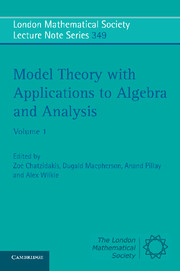Book contents
- Frontmatter
- Contents
- Preface
- Contributors
- Model theory and stability theory, with applications in differential algebra and algebraic geometry
- Differential algebra and generalizations of Grothendieck's conjecture on the arithmetic of linear differential equations
- Schanuel's conjecture for non-isoconstant elliptic curves over function fields
- An afterthought on the generalized Mordell-Lang conjecture
- On the definitions of difference Galois groups
- Differentially valued fields are not differentially closed
- Complex analytic geometry in a nonstandard setting
- Model theory and Kähler geometry
- Some local definability theory for holomorphic functions
- Some observations about the real and imaginary parts of complex Pfaffian functions
- Fusion of structures of finite Morley rank
- Establishing the o-minimality for expansions of the real field
- On the tomography theorem by P. Schapira
- A class of quantum Zariski geometries
- Model theory guidance in number theory?
Model theory guidance in number theory?
Published online by Cambridge University Press: 04 August 2010
- Frontmatter
- Contents
- Preface
- Contributors
- Model theory and stability theory, with applications in differential algebra and algebraic geometry
- Differential algebra and generalizations of Grothendieck's conjecture on the arithmetic of linear differential equations
- Schanuel's conjecture for non-isoconstant elliptic curves over function fields
- An afterthought on the generalized Mordell-Lang conjecture
- On the definitions of difference Galois groups
- Differentially valued fields are not differentially closed
- Complex analytic geometry in a nonstandard setting
- Model theory and Kähler geometry
- Some local definability theory for holomorphic functions
- Some observations about the real and imaginary parts of complex Pfaffian functions
- Fusion of structures of finite Morley rank
- Establishing the o-minimality for expansions of the real field
- On the tomography theorem by P. Schapira
- A class of quantum Zariski geometries
- Model theory guidance in number theory?
Summary
This note mentions several areas of number theory and related parts of mathematics where different aspects of model theory can potentially offer important new insights. The situations listed below are very well known to number theorists, but probably not so well to model theorists. I include just a short presentation of each of the examples, together with references to the literature. In some of them one can feel important similarities between two mathematical theories, which are still not formalized and well understood. A model theoretical analysis may provide a valuable help.
The main reason to hope for such developments involving model theory, for example as a bridge between two currently separated areas in mathematics, is that for many of the situations listed below it is natural to anticipate existence of certain common structures remaining invisible at the current level of knowledge. Model theoretical analysis could help to reveal some of those structures. In some of the situations one seeks a more algebraic construction lying behind analytical objects. And it is well known that model theory (e.g. parts such as nonstandard mathematics, geometric stability theory) provides a sort of algebraization of analytical constructions.
It is also appropriate to recall that Poizat compares the inclusion model theory — mathematical logic with the inclusion arithmetic — mathematics.
This note is an extended version of a talk given at a conference in spring 2005 inside the INI programme Model Theory and Applications to Algebra and Analysis.
- Type
- Chapter
- Information
- Model Theory with Applications to Algebra and Analysis , pp. 327 - 334Publisher: Cambridge University PressPrint publication year: 2008
- 1
- Cited by

